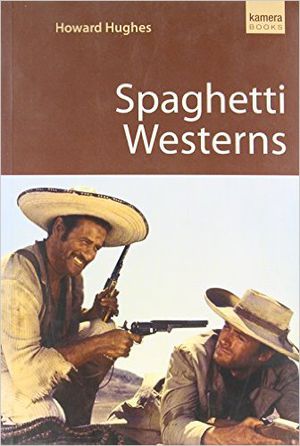Spaghetti Westerns - Howard Hughes Book Review
|
Related links:
|
This is an updated, expanded and revised edition of Hughes’ book previously published in the ‘Pocket Essential’ series and is designed to be an introduction to the genre for the new fan or someone interested in getting an overview of the genre. As such it has limited scope but within the confines of its remit and 150 page length it manages to cram in plenty of information in a very readable style.
The format of the book is straightforward and sensible. Starting with a potted history of the genre covering its rise and fall, main personnel and phases it gives the reader a compact overview of how the Spaghetti Western phenomena emerged, flourished and eventually faded away. It also covers at some relative length the contribution made by the composers of the films music and emphasises the importance these scores played in the effectiveness and memorability of these films. Ennio Morricone, unsurprisingly, gets particularly wide discussion here. From then on, the rest of the book is made up of a series of mini reviews of the actual films, 34 in all, lumped together in chronological clusters under chapter headings which play on the genre’s relative popularity at the time: Rome on the Range 1964-65, Coffers Full of Dollars 1966, Box Office Dynamite 1967-68 and End of the Trail 1970-76. Each chapter being filled with reviews of the films Hughes sees as the ones which made the biggest impact and which he recommends most to the novice fan. These reviews are very similar in layout to that utilised by Alex Cox in his recent book also published by Kamera, 10,000 Ways to Die. That is: synopsis, background discussion and verdict for each film along with a basic list of personnel and it works very well; allowing for a basic overview and some personal opinion from Hughes while putting each film in its chronological context to the wider genre.
The author obviously knows his stuff and there were only one or two errors which I picked up, a very good record to be fair when writing on a subject so full of conflicting and contradictory comments and misinformation. Rest assured, this is no Thomas Weisser like book, Hughes has clearly seen all the films he describes, although I was dismayed to see that Big Bad Tom’s book still gets a mention in the bibliography.
Hughes acknowledges the limits of a book of this type and size. He could not fit in more than the 34 films he has for discussion and so his choices are inevitably subjective. Most fans, I think, would struggle to make such a restrictive selection while doing justice to the best of the genre and I think the author’s choices are a pretty decent representation. Although there were a few films I might have replaced if the choice had been mine the only obvious omission I felt was the lack of discussion of the Sartana films, the first of which is only mentioned briefly in connection to Sabata. Based on Hughes’ own well made point that a film’s impact is best judged in the genre by the number of the rip offs it sires, Sartana was worthy of more attention. Apart from that though, most films you would expect to see are included as well as one or two which are possibly a little more surprising and Hughes does a good job of giving a well rounded taste of genre.
As mentioned above, this is a revision of the previously published Pocket Essential edition and in its new, more attractive presentation Hughes has been able to add some nice colour illustrations (mostly posters and lobby cards) and update the bibliography, recommended websites (thankfully we get a mention) and other reference materials sections. He also was able to update the UK DVD releases list. This is a welcome addition but, in this internet age, I would have liked to see a better guide to some of the overseas releases, especially the German ones, which the new fan in Britain may not be aware of and without which many of the best films of the genre are impossible to access. This is a small criticism however and, to be fair, a list of any kind like this is rare and well appreciated.
All in all this is a great little ’introduction to the genre’ book which offers key information and some interesting opinion from the author. It’s target is clearly the new fan or curious film buff and, as such, the long term fan will find little new here but it is an interesting read all the same and does what it sets out to well. If you have a friend or family member who you think might enjoy the genre it would make a great little birthday or Christmas present to help them learn more about it. Of course, that being said, the more knowledgable fan will probably still have a place for it on their shelves just for the sake of ‘completism’. It certainly fits well on mine. --Phil H 18:01, 6 March 2010 (UTC)




